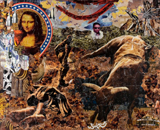
One of the best aspects of the Manhattan art scene, and perhaps my favorite, is its diversity. You need only go to a handful of galleries to experience a broad range of concepts and aesthetics. Once in a while, you hit a few shows that blow out the borders a notch or two, keeping the whole thing increasingly fresh and expansive.
This is the case with two current exhibitions, Michael Anderson: Media Violence at Marlborough Chelsea, and Hiroshi Senju at Sundaram Tagore Gallery. Michael Anderson's art has painterly, fluid, reactive and compelling iconography culled from street posters.
The iconography jumps from the glare of fashion models in "Strange Party" (2007) and the "Kung Fu Hustle" series to looming, weighty depths reminiscent of a Flemish School battle scene in works such as "Bull by the Horns" (2007, above right).
And since Anderson often uses multiples of the same image in a single work, he can create a certain rhythm and movement that activates sections of that individual work in various ways. This is most obvious in "Jack da Vinci Johnson" (2006), a work which, if you take away the recognition of any of the specific individuals, looks something like an aerial view of an amusement park where you would have a similar cacophony of movements and sounds all competing for your attention. Here, though, it all seems to coalesce into a very tactile, very visceral composition that makes culture seem more about ritual and less about recognition.
"Presently Untitled" (2006) is the work that I found to be the most unique with respect to the use of the artist's sole medium, street posters. The variety of times and cultures in "Presently Untitled" -- the abstraction, the words, and messages -- and the various focal points can lead you in countless mental directions while the composition, which is left leaning yet buoyant, somehow keeps it all down and captive. 
The polar opposite of the Anderson collages, which I happened to see quite by accident over at Sundaram Tagore Gallery, is the work of Hiroshi Senju. Here, all of the mental activity that was conjured up by the Anderson exhibition was cooled and tamed by Senju's luminous paintings. And when I say luminous, I mean that literally, since the artist uses black lights and fluorescent pigments. Each work, which takes up most of the wall it hangs against in this darkened gallery space, has a deep dark background on which the artist -- as he has done in the past with organic materials such as pulverized rocks, plants and shells -- pours liquid fluorescent pigment to more than suggest a waterfall.
I have to say, I am not normally so impressed with something as cliched as a waterfall, but Senju knows how to handle such things, doing it with incredible reverence and flawless technique. Walking through the space surrounded by the half dozen or so of these shimmering fall representations, you can actually feel yourself calming down, while the brilliance of the fluid light in each painting gives you a peaceful focus.
I left both exhibitions wanting to see the work again, and feeling that I was truly moved by the art that I saw and experienced.
